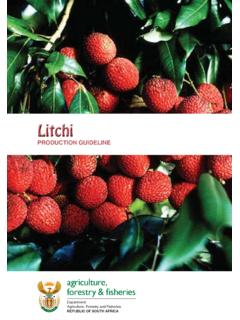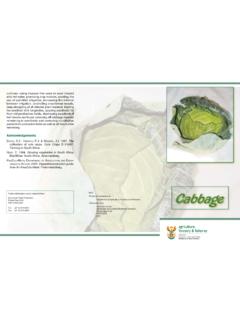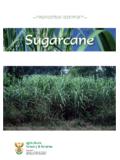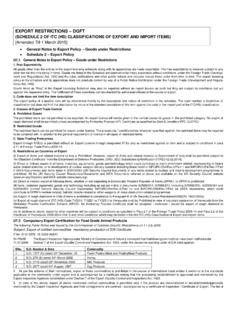Transcription of A PROFILE OF THE SOUTH AFRICAN MACADAMIA NUTS …
1 A PROFILE OF THE SOUTH AFRICAN MACADAMIA NUTS MARKET VALUE CHAIN. 2012 . Directorate Marketing Private Bag X15. ARCADIA. 0007. Tel: 012 319 8455/6. Fax: 012 319 8131. Email: TABLE OF CONTENTS. 1. DESCRIPTION OF THE 3. Employment .. 4. Production trends .. 4. Production areas .. 4. 2. MARKET STRUCTURE .. 6. Domestic markets .. 6. 3. EXPORTS AND IMPORTS .. 7. Exports .. 7. Share analysis ..13. SOUTH AFRICAN MACADAMIA Nuts Imports ..14. 4. PROCESSING ..16. 5. LOGISTICAL Storage ..19. Quality ..19. Shelling ..19. Drying ..19. Packaging ..19. 6. MARKET INTELLIGENCE ..21. 7. MARKET COMPETIVENESS ..23. 8. INDUSTRY ORGANIZATION ..25. 9. OPPORTUNITIES ..25. 10. THREATS ..25. 11. OTHER CHALLENGES ..25. 12. SAMAC AFFILIATED MACADAMIA MARKETING COMPANIES ..26. 13. ACKNOWLEDGEMENTS ..27. 2. 1. DESCRIPTION OF THE INDUSTRY. MACADAMIA nuts are quickly becoming an important crop in SOUTH Africa and are possibly the fastest growing tree crop industry in the country. SOUTH Africa is the third largest MACADAMIA nut producer in the world, after Australia (where they originated) and Hawaii.
2 The nuts are a valuable food crop. Only two of the species M. integrifolia and M. tetraphylla, are of commercial importance. MACADAMIA tree takes five to twelve years to produce nuts and a good tree can produce nuts for 40 years. The trees require a hot subtropical climate without much humidity. In SOUTH Africa, KwaZulu-Natal, Mpumalanga and Limpopo are ideal areas. Macadamias are now widely used in the confectionery, baking, ice cream and snack food industries. MACADAMIA oil's rich, cushiony skin feel and high oxidative stability make it especially suitable for heavy creams and sun care formulations. Medical research has shown that the consumption of macadamias may significantly lower the risk of heart disease. The gross value of MACADAMIA nuts is shown in Figure 1 below. Source: SAMAC data 2011. Figure 1 above illustrates the contribution of the MACADAMIA nuts industry to the total gross value of agricultural production over a 10 year period. The industry's contribution increased steadily from 2003 to 2004.
3 In 2005 the industry's contribution dropped by compared to the 2004. production season. This can be attributed to a drop in production volume and market prices in the same season. From 2006 the industry's contribution increased steadily reaching a peak in 2008. In 2009, the industry's contribution decreased by 35% compared to the previous season. This is attributed to a loss of R54 million worth of nuts that were lost due to unsound kernels (SAMAC. 2009). In 2010, MACADAMIA nuts gross value declined by 53% compared to gross value in 2009. This can be attributed to a decline in MACADAMIA prices in the same year. During 2011, the gross value of production increased by 15% when compared to the previous season. Employment Although most of the workforce in the industry is employed seasonally for harvesting and processing from February to August, it is estimated that at least 3 000 new job opportunities have been created on MACADAMIA farms over the last decade and another 1 000 jobs in cracking facilities.
4 In peak season, the industry presently provides employment for more than 4 500 farm workers and about 1 500 factory workers. Since production is expected to double within the next 5. to 7 years, employment creation will continue to grow at a similar pace. Production trends Production areas In SOUTH Africa, MACADAMIA nuts are mainly grown in three provinces: Limpopo (Tzaneen and Levubu), Mpumalanga (Barberton, Nelspruit and Hazyview), and on the north and SOUTH coast of KwaZulu Natal. In the neighboring countries macadamias are produced in Swaziland, Malawi and Zimbabwe. There are close to 1 000 farmers involved in growing MACADAMIA nuts that are supplied to 12 cracking factories. MACADAMIA nuts are also grown in Brazil, California Israel, Thailand, Kenya, Swaziland, Costa Rica, New Zealand Colombia and Guatemala. Source: SAMAC data, 2010. Figure 2 above shows that in 2010, Mpumalanga province accounted for 8 820 ha of MACADAMIA nuts, followed by Limpopo with 5 105 ha, Kwazulu Natal with 2 859 ha, Eastern Cape with 400 ha and the other provinces cultivated 183 ha.
5 In terms of number of trees planted, Mpumalanga has over 2 million, followed by Limpopo with over million, Kwazulu Natal with approximately 694. 000 and Eastern Cape with 150 000. 4. Source: SAMAC data, 2011. Figure 3 above illustrates the production of MACADAMIA nuts (Dry In Shell -DIS) over a 10 year period (also see Table 1 below). From 2003 to 2004, production increased steadily and in 2005. there was a decrease in total tonnages compared to previous year. This is attributed to bad weather during flowering and fruit set in Limpopo province. From 2006 production increased steadily reaching a peak in 2011. In 2009 season, SOUTH Africa produced 24 199 tons DIS. MACADAMIA (table 1 below). This is a increase compared to the previous season. In 2010, production of dry in shell MACADAMIA nuts have increased by 12% when compared to 2009. production year. Production growth is a factor of tree age, climate and production practices. In 2011, DIS output increased by when compared to 2010 production season.
6 Table 1: MACADAMIA production per production region in 2011. Processed MACADAMIA Limpopo Mpumalanga KZN Total RSA. Wet In Shell (WIS) (kg) 9 770 240 20 704 235 2 612 028 33 086 503. Dry In Shell (DIS) (kg) 9 053 648 19 022 693 2 299 293 30 375 634. Sound Kernel (SK) (kg) 1 985 828 5 661 235 772 417 8 419 480. Unsound Kernel (USK) (kg) 320 069 583 839 96 810 1 000 718. Total Kernel (TK) (tons) 2 305 897 6 245 074 869 227 9 420 198. SKR1% USKR2% TKR3% Source: SAMAC DATA, 2011. 1. SKR = Sound Kernel Recovery 2. USKR = Unsound Kernel Recovery 3. TKR = Total Kernel Recoverry 5. 2. MARKET STRUCTURE. There is no regulation or restriction in the marketing of MACADAMIA nuts. The prices of MACADAMIA are determined by market forces of demand and supply. The industry is export based with more than 95% of annual production shipped to international markets. The United State of America, Europe and Asia are presently the largest markets for macadamias originating from SOUTH Africa.
7 There are close to 1 000 farmers involved in growing MACADAMIA nuts that are supplied to 12. cracking factories. A number of these growers have already achieved GLOBALGAP accreditation and many of the cracking facilities are HACCP and/or ISO 9001 accredited. Domestic markets The main buyers of MACADAMIA nuts in SOUTH Africa are Spar, Pick 'n Pay and Woolworths. MACADAMIA nuts are also marketed through national fresh produce markets and directly to processing companies. Volumes of sales of MACADAMIA nuts at the national fresh produce markets (NFPMs) are depicted in Figure 4. Source: Statistics and Economic Analysis, DAFF. The sales volumes have relatively fluctuated over the years. In 2003, market prices eased higher by 27% despite an 88% increase in MACADAMIA volumes supplied in the market. This can be attributed to strong demand of MACADAMIA nuts in the same year. In 2006 the volumes fell by 66%. compared to the previous year and this was accompanied by a 4% decrease in market prices.
8 From 2007 the market prices increased significantly reaching a peak in 2008. In 2009 the market prices dropped by 37% due to the highest volumes supplied across the markets. In 2010, volumes supplied at the market increased by 28% which lead to a drop in market prices. During 2011, MACADAMIA nuts prices dropped by despite a 27% drop in volumes supplied across the markets. This can be attributed to poor uptake of MACADAMIA nuts at the same year. 6. 3. EXPORTS AND IMPORTS. Exports Given the large number of young trees yet to come into production, the industry has tremendous growth and development potential. Over 90% of the production (12% of world production) is exported annually. According to ITC Trademap during 2011, SOUTH AFRICAN MACADAMIA nuts export represented of world MACADAMIA nuts exports and it was ranked no 1. In second place was Australia followed by the Netherlands, Kenya, Guatemala and Hong Kong China. Source: ITC Trademap Figure 5 above illustrates SOUTH AFRICAN MACADAMIA nuts export destinations in 2011.
9 The United States of America with share is SOUTH Africa's largest export market for MACADAMIA nuts, followed by Hong Kong, China with and Netherlands with 19% share. SOUTH Africa also exported MACADAMIA nuts to Germany, United Kingdom, Japan, Spain, Chinese Taipei, and Italy. Figure 6 below shows that in 2008 MACADAMIA nuts exports decreased slightly by compared to 2007 exports. In 2009, the tonnages exported increased by compared to the previous season. This can be attributed to high production volumes in the same year. It was less profitable to export in 2007, since less export values were recorded for high volumes exported. In 2010, the exports declined by despite an in increase in production volumes. It was more profitable to export MACADAMIA nuts in 2010, since high value was recorded for less volume exported. During 2011, MACADAMIA nuts exports increased by 42% when compared to the previous season. This can be attributed to a increase in domestic production output.
10 In 2011, it was highly profitable to export MACADAMIA nut when compared to other years 7. Source: Quantec Easydata * MACADAMIA nuts individual HS code was developed in 2007; it was previously classified in total nuts code and the available exports data is only for 5 years. Exports of MACADAMIA nuts to various regions of the world during the last five years are presented in Figure 7. Source: Quantec Easydata Figure 7 above indicates that high quantities of MACADAMIA nuts were exported to Asia, European and Americas regions. In 2008, considerable volumes of MACADAMIA nuts were exported to the AFRICAN region. MACADAMIA nuts exports to Oceania were insignificantly low. In 2010, SOUTH Africa exported high quantities of MACADAMIA nuts to the Asian region (Hong Kong, China, Japan and Viet Nam) followed by Americas (United States of America) and European region (Netherlands, 8. Spain, United Kingdom and Germany). During 2011, high quantities of MACADAMIA nuts were exported to Asian region (Hong Kong, China and Japan), European region (Netherlands, Germany and United Kingdom) and Americas (United States of America).











